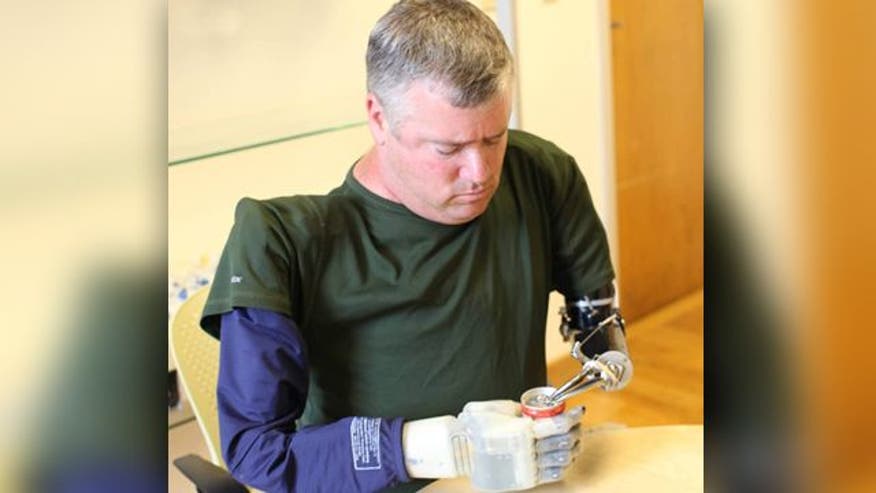
Restoring hands, arms, feet, and legs to those wounded in the service of our country should be a national priority…and now, finally, it is, thanks to some very promising technological advances.
Technology advances in area such as body armor and medical response have helped save many, many, wounded U.S. warfighters’ lives. However, many who survive are permanently wounded and today’s generation of warfighters has to contend with an unprecedented frequency of limb loss. The Defense Advanced Research Projects Agency (DARPA) is committed to building highly sophisticated prostheses, giving wounded servicemembers and veterans naturally functioning limbs.
The HAPTIX (Hand Proprioception and Touch Interfaces) project is working on creating a solution for amputees. This solution would be implanted and directly communicate with the nervous system and brain. This means that a person could think and the hand and arm would move intuitively and function just like a natural hand, complete with the dexterity and sense of touch.
The agency has recently moved its HAPTIX program forward by selecting eight teams that will advance the development of next-generation, state of the art upper-limb prostheses. In particular, they are focusing on creating hands that will move and have a sense of touch like natural ones.
The aim is to create a hand that’s comfortable, feels natural, and works so effectively that users will want to wear it around the clock. Ideally, HAPTIX will mean those who wish to return to active duty can do so, and the technology will boost quality of life for all users.
In a statement, DARPA Program Director Doug Weber explained that “once development of the HAPTIX system is complete, we want people to benefit immediately and be able to use their limb all day, every day, and in every aspect of their lives…the experience needs to be comfortable and easy.”
Approximately 80 percent of amputees have to endure phantom limb pain. The hope is that these new devices will also help alleviate, if not eliminate, this pain.
Integrating Thought and Movement
For more than 10 years, DARPA has been relentlessly advancing prosthetic limbs in an attempt to revolutionize the devices. The agency, for example, recently debuted two advanced mechatronic limbs for the upper body. Truly leveraging these revolutionary devices, though, means restoring the link between thought and the hand and arm devices.
Conventional methods to connect thought with prosthetic devices were inadequate. Without this connection, users can’t “feel” things they touch or things that touch them. Also, if they close their eyes, they won’t have awareness of limb position and movement like someone would with the connections of a natural limb.
HAPTIX will therefore also harness the advanced work DARPA has already undertaken on RE-NET (Reliable Neural-Interface Technology), as part of its Revolutionizing Prosthetics program launched in 2006. RE-NET has made great strides in creating a direct link between a person’s thoughts and intent and control over a prosthetic device. These neural-interface technologies will provide building blocks that could combine with HAPTIX advances. Interfaces will be incorporated that will give users not just intuitive control, but also sensory feedback.
Research revealed that after limb loss the motor and sensory fibers in the nerves can stay functional for many years. The idea is to tap into those signaling pathways so that a HAPTIX user’s device communicates and receives instructions using them. The net result is that users can control and sense the hand and arm the same way they would a natural hand and arm.
In the 2015 State of the Union Address, President Obama underscored the importance of programs like HAPTIX. “I want Americans to win the race for the kinds of discoveries that unleash new jobs — converting sunlight into liquid fuel; creating revolutionary prosthetics, so that a veteran who gave his arms for his country can play catch with his kids again,” he said.
Other programs are also making significant headway. Last year, the Johns Hopkins University Applied Physics Laboratory made history when a bilateral shoulder-level amputee wore and controlled two Modular Prosthetic Limbs with just his thoughts. Les Baugh had lost both arms in an electrical accident 40 years previously. In preparation for the new system, Baugh underwent targeted muscle reinnervation surgery.
Next steps?
The eight teams working with DARPA include: Case Western Reserve University, Cleveland Clinic, Draper Laboratory, Nerves Incorporated, Ripple LLC, University of Pittsburgh, University of Utah, and University of Florida.
In order to get the devices as quickly as possible to those wounded in military service, DARPA has been pushing forward in a number of ways, from advance consultation with the FDA through to leveraging commercially available advances made for other applications, like cardiac pacemakers.
The potential for HAPTIX may extend well beyond the military and it could eventually help those with medical amputations, as well as neurological diseases, spinal cord injuries, and more.
DARPA is also providing a variant of the DARPA Robotics Challenge Simulator to help teams accelerate research, design and testing. Amputees will also have a chance to use the simulator to learn how to use their new prostheses in a realistic way.
For the teams that make it through the first phase, they will then enter Phase 2, where chosen tech components will be integrated into a complete HAPTIX test system. The plan is then to commence 12 month take-home trials of a complete, FDA-approved HAPTIX system within a four-year timeframe.
Ballet dancer turned defense specialist Allison Barrie has traveled around the world covering the military, terrorism, weapons advancements and life on the front line. You can reach her at wargames@foxnews.com or follow her on Twitter @Allison_Barrie.

